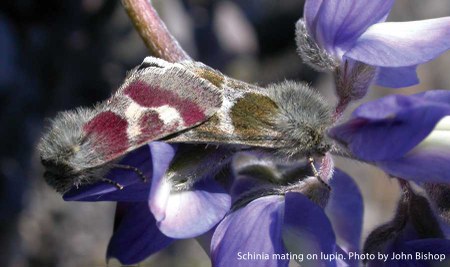
by Joan Miller
Even after 34 years, the process of plant recolonization is still going on at Mount St. Helens. To go from moonscape to
forested landscape is a long process, and scientist John Bishop finds it “wondrous.” John, an ecologist and professor at Washington State University’s School of Biological Sciences, Vancouver, has been conducting research at the national monument for 25 years, starting as a grad student. He says his initial focus was evolutionary genetics. What better place to study than a landscape that was almost biblical: it was ripe for any kind of evolution.
The 1980 blast sterilized parts of the landscape, destroying forests and wiping out plant and animal life. But Bishop says some plants and animals survived underground or under snow. Ash, avalanches and pyroclastic flow obliterated everything in their paths. But life does find a way, and the first pioneers spotted rising from the ash were lupines, John explains. But not the common lupine that can be seen all over the mountains in summer. The pioneer lupine was Lupinus lepidus var. lobbii, a dwarf lupine. This hardy little purple flower is only 4-6 inches high and likes to grow in pumice and hot dry areas such as slopes of volcanoes. Lupines have special powers: they can fix nitrogen, which is vital in an environment where there is none. But they also have special adaptations for obtaining other elements, and can self-pollinate, which was handy in a place with no pollinators.
How the first lupines got started in the blast zone is a bit of a mystery, but John explains that there was an initial “pulse” of phosphorus released by the pumice, and scientists also think that enough insects were blown in over time to build up nutrients that may have supported lupine seeds that were also blown in. In any case, lupine colonies expanded, along with the insect population. There developed a classic ecological situation where the various resources were the controlling factors in the ecosystem. As one population would rise, another species would bring it down. John discovered that the lupines, a keystone species at the monument, were being attacked by insects, and this interaction became a center of his research.
“We’re studying a place where everything has to colonize from the outside; nothing was left after the blast,” he says. “Each species that comes in has a period when no enemies are there, and they can flourish. When enemies arrive, the plants or insects they feed on are reduced in number.”
Most of his research is on the “Pumice Plain,” the area between Spirit Lake and the crater on the north side. It was buried deeply by an avalanche, then by pyroclastic flow. “There was virtually nothing available for plants and animals to use. It takes real specialized species to succeed,” he says.
Today, Mount St. Helens is a biodiversity hotspot, says John. Many tree species have only just begun to show up on the pumice plain, including conifers. But along with the return of native species has come an influx of invasives that were not there before the blast. John says especially along roadways, where car tires help transport seeds, you can find strongholds of nonnatives.
Building on his plant studies, Bishop sees a natural bridge to studying the effects of climate change at Mount St. Helens. “We’re looking at colonization of new surfaces, so our results could apply to other places. For example, where glaciers have retreated or as species migrate to higher altitude or latitude,” he explains.
“There is always something new to see out there. I never tire of it.” Spoken like a true scientist
This article originally appeared in our November/December 2014 issue of Mountaineer magazine. To view the original article in magazine form and read more stories from our publication, click here.
 Joan Miller
Joan Miller